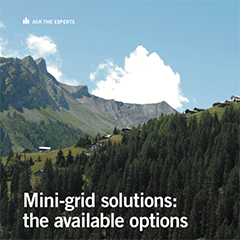Mini-grids have become the solution for efficient and economic electrification in developing countries and in remote areas. PES gets an overview of the different configurations available from Pablo Muñoz, Technical Support Manager at Studer Innotec*. He will also be a guest speaker, at the Intersolar Europe Conference 2018, on this topic.
PES: Welcome to PES Solar/PV magazine. Thanks for talking with us. Being a mini-grid expert, perhaps you could start by clarifying the terminology used in this field. For instance, mini-grids, microgrids and nanogrids, are these many names for the same thing?
Pablo Muñoz: Yes and no. All three terms refer to an electricity distribution network that is smaller than typical regional or nationwide distribution networks. It is easy to find more specific definitions online but they are sometimes contradictory. At Studer Innotec, we use the term mini-grid to describe an energy system with distinct economic entities between the producer/operator and user/consumers. More than a specific technological solution, it is a business model.
PES: Please tell us why you think we should use mini-grids for electrification?
PM: There are several reasons for using a mini-grid. For economic reasons, because for example, extending the national grid to certain areas of a country can become very costly. Also to obtain a reliable network, due to the fact that in some countries the national grid is heavily used and may be subject to black-outs. By having an autonomous grid the electricity is guaranteed. And of course, renewable energy is cleaner than both fossil fuels and nuclear power.
PES: If mini-grids are so great, why aren’t there more of them?
PM: The main difficulty of implementing mini-grid projects is not technical, but defining a business model around its implementation: how to fund the project, make a viable business out of it, how to secure the investment, how to regulate/stabilise the consumption, and how to equally allocate the limited resources.
On the bright side I like to think about the mobile phone paradigm, where the decentralised solution has prevailed over the fixed phone line, especially where there is a lack of facilities. I envisage a very similar development in the energy sector, where the mini-grid will play a key role in rural electrification, especially in places where the centralised grid infrastructure hasn’t been developed.






























